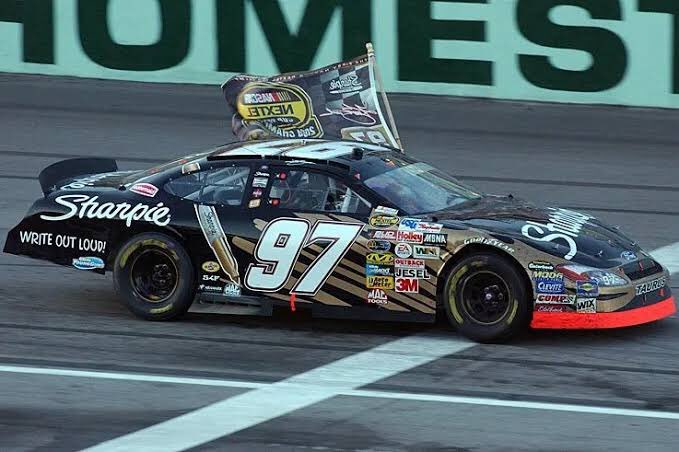November 21, 2004, was a day when sports fans across America had to make a tough choice. On one hand, the NFL offered a high-stakes matchup between the Buffalo Bills and the St. Louis Rams. On the other, NASCAR promised drama, intensity, and history with the season finale of its first-ever Chase for the Nextel Cup at Homestead-Miami Speedway. What unfolded wasn’t just a thrilling day of competition—it became a defining moment in NASCAR’s history, with a record 10 million viewers tuning in to witness one of stock car racing’s most dramatic title fights yet.
The Bills, the Rams, and NASCAR’s main event
For NFL fans, the game in Buffalo was memorable enough. The Bills dominated the Rams 37-17, fueled by standout performances on both defense and special teams. Terrence McGee electrified the home crowd with an 87-yard kickoff return for a touchdown, and Willis McGahee pounded the Rams’ defense with powerful runs, extending the Bills’ playoff hopes for another week.
ADVERTISEMENT Article continues below this ad
But as the clock ticked down in Buffalo, the real story of the day was unfolding on a 1.5-mile oval in South Florida. With its championship on the line, the inaugural “Chase for the Nextel Cup” was reaching its dramatic crescendo, and millions of fans across the country couldn’t look away.
Homestead-Miami Speedway had all the makings of a true racing spectacle that day. The 2004 Ford 400 was more than just the last race of the season; it was the ultimate test of NASCAR’s bold new playoff-style championship format. The stakes had never been higher, and the drivers in contention were some of the biggest names in the history of the sport.
Leading the championship was then-26-year-old Kurt Busch, driving for Jack Roush Racing and poised to secure his first title. But his lead was slim, with Jimmie Johnson breathing down his neck just 18 points back. NASCAR legends Jeff Gordon and Dale Earnhardt Jr. were also in the hunt, though Gordon, trailing by 21 points, had the stronger chance to challenge Busch.
The pressure was immense. For Busch, it was about seizing a career-defining moment. For Johnson, Gordon, and Junior, it was about snatching the championship away in the season’s dying moments. The Ford 400 promised heartbreak, triumph, and the kind of nail-biting drama that only motorsport can deliver.
And boy, did it deliver.
The race began with all eyes glued to the four title contenders. Then, chaos erupted and almost ruined everything for Kurt Busch. Early in the event, his car developed a terrifying vibration as his right front wheel worked itself loose. Busch barreled toward pit road with the car on the verge of calamity, narrowly avoiding a collision with the pit wall. It was a miracle he kept it together.
Busch’s crew worked feverishly to repair the car and send him back into the fight. It was a defining moment of grit and perseverance, setting the stage for what would become one of the most memorable finishes in NASCAR history.
The checkered flag belonged to Greg Biffle that day, but the story wasn’t about the race winner. As the laps wound down, the real race was in the points standings. Jimmie Johnson was putting up a valiant fight, finishing second in the race, but Busch’s fifth-place finish was just enough to secure the championship. The final margin? A razor-thin eight points—the closest title battle in NASCAR’s modern era at the time.
November 21, 2004: At Homestead, NASCAR crowned a champion under their 10-race playoff format for the first time
With 9.9 million viewers, it remains the most-watched NASCAR race ever that went against the NFL pic.twitter.com/FCfSKi6aDz
— nascarman (@nascarman_rr) November 21, 2024
After climbing out of his car, Busch could barely contain his emotions. “This is what a team does to win a championship—they persevere on a day such as this,” he said, crediting his crew chief Jimmy Fennig and his team’s determination. “Jimmy is a true leader, and he really helped me understand what I needed to do with the race car to make it go fast.”
In his post-race interview, Busch admitted how close he had come to losing it all. “We feel like we dodged a huge, huge, devastating proposition that would have taken us out of this championship,” he said. “And we pulled through.”
It wasn’t just about his team, though. Busch’s thoughts also turned to the NASCAR community, still mourning the recent Hendrick Motorsports plane crash tragedy that had claimed 10 lives, including the president of HMS John Hendrick, his daughters, and his son Ricky Hendrick. Choked up, Busch said, “This championship is for Jimmy Fennig. But my heart is with Hendrick and everyone affected. It’s unbelievable.”
A record-breaking day
ADVERTISEMENT Article continues below this ad
Trending
What made this race even more remarkable was the way it captured America’s attention. Despite going head-to-head with NFL games, including the Bills-Rams clash, NASCAR’s Ford 400 drew an astonishing 10 million viewers. The number set a record for NASCAR at the time, proving the sport could hold its own against football—a feat that had seemed almost unthinkable.
The reasons were clear. The new Chase format created a winner-takes-all energy that fans couldn’t resist. Drivers like Jeff Gordon, Dale Earnhardt Jr., and Jimmie Johnson pulled in casual viewers. And the drama of Homestead’s finale was unmatched. It was the kind of story you couldn’t script, and it kept fans on the edge of their seats until the final lap. The championship battle validated the format’s ability to deliver unforgettable moments, solidifying it as a staple of the sport for years to come (for better or worse).
For Kurt Busch, it was the crowning achievement of his young career. At just 26, he became the third-youngest champion in NASCAR history, a feat he achieved with grit, determination, and a little luck. Looking back, Busch summed it up perfectly: “It’s an unbelievable deal. Many things have to fall into place to win a championship, and today we showed what it means to persevere.”
ADVERTISEMENT Article continues below this ad
That day, NASCAR didn’t just outdraw the NFL in viewership—it showed that the sport’s blend of speed, skill, and storylines could captivate an entire nation. For one glorious Sunday in November, NASCAR wasn’t just competing with football. It was beating it.



